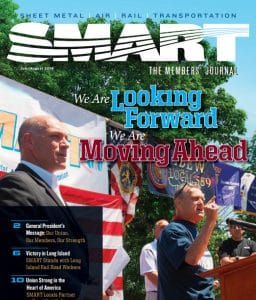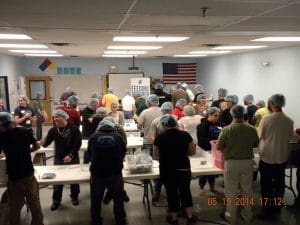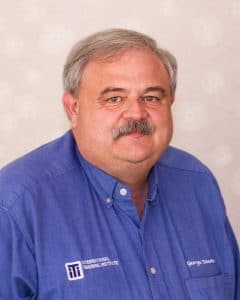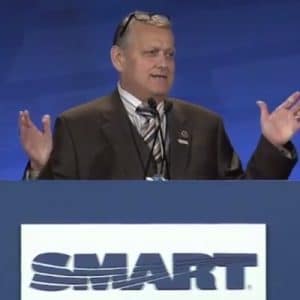
Over the course of the convention, delegates and committee members will meet and vote to ratify and finalize a new SMART Constitution, to elect a slate of officers, and to discuss reports on topics relevant to the industries and professions represented by SMART.
Guest speakers at the convention are set to include AFL-CIO President Richard Trumka, President Sean McGarvey of North America’s Building Trades Unions, Nevada AFL-CIO Executive Secretary-Treasurer Danny Thompson, Southern Nevada AFL-CIO Building and Construction Trades Council Secretary-Treasurer Darren Enns, and Fred Myers of the Union Sportsmen’s Alliance. SMART General President Joe Nigro and Sheet Metal and Air Conditioning Contractors’ National Association President Randy Novak are also slated to address the delegates.
The First SMART General Convention is also notable for its use of electronic voting and the use of e-readers to distribute convention daily news to all delegates. This green approach to convention communication falls directly in line with SMART members’ participation in green technologies on the job—through innovative HVAC practices and energy efficiency along with daily work in transportation systems (like rail and mass transit) that reduce greenhouse emissions and our dependence on foreign oil.
The International Association of Sheet Metal, Air, Rail and Transportation Workers, is one of North America’s most dynamic and diverse unions with 216,000 members. SMART’s members produce and provide the vital services that move products to market, passengers to their destinations and ensure the quality of the air we breathe. We are sheet metal workers, service technicians, bus operators, engineers, conductors, sign workers, welders, production employees and more. With members in scores of different occupations, we advocate for fairness in the workplace, excellence at work and opportunity for all working families.
For more information, visit the SMART website at smart-union.org.
Author: paul

“Green” can be a buzzword, or it can be a way of life and doing business. Sheet Metal Workers Local No. 10 in White Bear Lake, Minnesota and Local No. 20 in Indianapolis are two examples of schools that are not only incorporating green initiatives into their work, but they are teaching sheet metal workers of the future how to incorporate it into their industry.
Energy efficiency in Indiana’s five training centers began with the Indianapolis school, which sunk its energy bills by sinking four coil cribs in a nearby pond to use water as an energy source to heat and cool the training center using geothermal equipment. Since the fall of 2012, four coils have been placed in the pond. This summer the three remaining heating/cooling systems will be replaced when coils are buried in the earth, which stays at around 55 degrees, using another form of green energy.
In both cases, instead of using air to either cool coils or pull heat out of the air, the systems are using the water or ground temperature to do the work, said Tim Myres, training director in Indianapolis.
“Our utility bills have dropped significantly,” Myres said. Compared to the last two years, April’s electric bill was 25 percent less, and the natural gas bill has been reduced to nearly nothing. All the hot water in the building is produced by geothermal systems as well.
“As utility prices go up, people are looking for a way to heat and cool their facilities. In Indiana, there has been increased interest in geothermal. People’s utility bills are high no matter what time of the year it is. Here, it’s 100 degrees in the summer and -10 degrees in the winter.”
The renovation to the center’s heating and cooling system provided training opportunities for the apprentices, who are working for contractors who work to meet consumer demand to help lower utility bills.
“Everything we’ve installed we’ve installed as a teaching module. As we teach geothermal theory, or installation or service, they can practice on the training center’s systems,” Myres added. “We’ve had a lot of requests in the last year or so for green energy training from members and contractors. And there is a big push on service training in Local No. 20. This goes hand-in-hand with that, also.”
At Local No. 10 in Minnesota, the membership encourages and entices apprentices and journeymen to study for and pass the Leadership in Energy and Environmental Design (LEED) Green Associate exam with a reimbursement and bonus program. The training center will reimburse the apprentice or journeymen the $250 exam fee, and – if they pass – a $150 bonus. To date, 20 members have been credentialed.
Apprentices who achieve the credential also are credited with 40 bonus school hours to use as a substitute for any of their regularly school time. Studying for the exam takes at least 40 hours, so giving those hours back when they pass adds flexibility the apprentices appreciate, said Buck Paulsrud, training director for Local No. 10.
“You have to know the material and be pretty well-rounded. In today’s construction world, the white hats, the ones who manage the job site – an awful lot of those people are LEED credentialed, and we’re driving that level of expertise to the boots on the ground,” Paulsrud said. “If we use the wrong products, or if we park on a part of the site that can’t be disturbed, that loses (LEED) points for the project that can’t be regained. Anybody on the site can screw up these points. Once they’re gone, they’re gone.”
Employers seek apprentices and journeymen who are LEED credentialed order to offer the expertise to entice projects.
“The individuals who have earned their credential have gained new employment or bettered themselves with their employer. The people who get this tend to do very well,” Paulsrud said. “The first apprentice who earned this was unemployed. After he earned the credential, he got hired right away. The employer reached down past all the other out-of-work apprentices in front of him and grabbed him because they wanted this expertise in the field.”
Recent green projects include the future new Vikings football stadium and the recently completed Target Field and TCF Bank Stadium.
“Even projects that aren’t LEED-certified are still built to LEED standards,” Paulsrud added. Utility bills are always a concern in regards to a business’ bottom line. “Some entities are choosing to follow all the rules to getting a greener building but don’t necessarily go for the certification.”

$500 Student Debt Eraser
Grants to help Mortgage and Insurance participants pay off their student loans. Apply Now! Grants are only available for as long as funds last.
$20K Student Loan Giveaway
June 1 to August 15 – enter to win up to $10,000 to pay off your student loans. We’ll put a major dent in the student loan debt of three lucky winners. Plus, more prizes, such as courses, consultations and books provided by The Princeton Review.
For details visit UnionPlus.org/Education today!

Each meal consisted of rice, lentils, vegetables and Himalayan salt, and each ingredient was put into a plastic bag, weighed and heat sealed. Each bag provides six child-sized meals. The majority of the meals went to children in Waterbury, Hartford and New Britain in Connecticut who only eat while at school. The meals packaged by the volunteers at Local #40 bridge the night, weekend and vacation gaps when nutritious food is not available.

Donovan, who works out of Centralia, Missouri, north of Columbus, covers schools in Nebraska, Missouri, Illinois, Kansas, Iowa and Arkansas for the ITI, the education arm of the unionized sheet metal and air conditioning industry. With 153 schools across the country, Donovan’s windshield time is spent supporting training directors at the 23 schools in his region and keeping staff members at those schools up on TotalTrack, the student-tracking database system.
“I go from area to area, and the only thing that changes is the local number,” Donovan said. “The sheet metal workers from all over the country are exceptional people.”
His time in the industry began in 1978 as a 22-year-old sheet metal apprentice when he came to the conclusion he wasn’t going to make any money as an airplane mechanic. He graduated in 1982 and worked as a journeyman and then foreman while also teaching part time at his alma mater. In 1994, he became the school’s apprentice director and took on the role as regional representative in 1997.
As a certified welding instructor (CWI), Donovan also serves as an assessor who completes audits of the industry’s welding facilities.
“The schooling I had as an airplane mechanic wasn’t wasted,” he said. “It was applicable to two different skills for different things. Airplanes had sheet metal. They had woodworking. They had all those systems in airplanes. They gave you a basic knowledge that was useful in other areas than just being an aircraft mechanic.”
Being a teacher involved with training and curriculum was never a job Donovan set out to fill when he entered the industry. But it’s one of the most rewarding, he said. The only thing he misses – creating and building things.
“The rewarding thing is being able to work with the local training schools and being able to assist them,” he added. “Whenever I was working with my tools in my local area, I didn’t have exposure to what else was going on in other places. After you meet all the talented people in our industry you realize. It’s a humbling experience.”
More than 15,000 apprentices are registered at the 153 training facilities in the United States and Canada. The ITI is jointly sponsored by SMART, the International Association of Sheet Metal Air, Rail and Transportation Workers (formerly the Sheet Metal Workers’ International Association) and the Sheet Metal and Air Conditioning Contractors’ National Association (SMACNA).
ITI supports apprenticeship and advanced career training for union workers in the sheet metal industry throughout the United States and Canada. Located in Fairfax, Va., ITI produces a standardized sheet metal curriculum supported by a wide variety of training materials free of charge to sheet metal apprentices and journeymen.
SMART Sheet Metal Workers Local 293 dropped off 18 boxes of school supplies at the Kapaa Elementary School in Kauai on Monday. The school was selected based on it servicing the greatest percentage of Kauai’s population, and the percentage of children on the free and reduced lunch program.
“We collected materials to take care of 10 schools, and this year, five schools on Oahu were serviced and five schools on the outer islands received supplies,” Rick Paulino, Local 296 President.
Life events continually remind us of how much we depend on each other. The Union Member Assistance Coordinators’ program serves the membership in many ways. Most importantly, we help our brothers and sisters cope with tragedies in their lives. We believe that a burden shared is a burden lessened. By sticking together and providing positive emotional support based on our experiences, we help each other get through difficult times in our lives and begin the healing process. That’s our mission!
Don’t walk away from a brother or sister who is hurting. Learn to reach out and become part of the solution. Remember that, “People don’t care what you know, until they know that you care.”
It is our union’s trademark. We can’t ignore our problems. Stop, listen and support those in need, as caring union members. Keep in mind always this adage, “As long as the ties that bind us together are stronger than those that will tear us apart, all will be well.”
SAMHSA (Substance Abuse and Mental Health Services Administration) Facts:
By 2020, mental and substance use disorders will surpass all physical diseases as a major cause of disability worldwide.
Half of all lifetime cases of mental and substance use disorders begin by age 14 and three-fourths by age 24
More than 34,000 Americans die every year as a result of suicide, approximately one every 15 minutes.
Each year, approximately 5,000 youth under the age of 21 die as a result of underage drinking. The annual total estimated societal cost of substance abuse in the Unites States is $510.8 billion. The total economic costs of mental, emotional, and behavioral disorders among youth in the United States is approximately $247billion.
Among persons aged 12 and older who used prescription pain relievers non-medically in the past 12 months, 55.9 percent got them from a friend or relative for free.
Member assistance contact: umac@smart-union.org
Members of the SMART Transportation Division and all of labor are reminded that they have the opportunity to make it federal law to have two qualified persons working on all freight trains operating in the United States a reality.
Now is the time to contact your legislators in the House of Representatives and ask them to co-sponsor and support H.R. 3040.
Introduced in the House Aug. 2 by U.S. Reps. Michael Michaud (D-Maine) and Chellie Pingree (D-Maine), this legislation will require that “no freight train or light engine used in connection with the movement of freight may be operated unless it has a crew consisting of at least 2 individuals, one of whom is certified under regulations promulgated by the Federal Railroad Administration as a locomotive engineer … and the other of whom is certified under regulations promulgated by the Federal Railroad Administration as a conductor pursuant to section 20163.”
“This legislation is not only about the safety of the American public and the safety of railroading operating crews, it is an opportunity to prevent what in my opinion is an unsafe operating practice – having only one crew member aboard a train,” said SMART TD President John Previsich. “This measure will not only protect our communities, it will protect our jobs.”
The legislation reflects heightened concerns over crew size arising from the tragic July 6 derailment of a Montreal, Maine & Atlantic fuel train in Lac Mégantic, Quebec, which killed 47 and destroyed the center of the town. The MM&A train was crewed by a single person.
The Association of American Railroads (AAR) and the American Short Line and Regional Railroad Association (ASLRRA) last year sent memos to Capitol Hill opposing this important piece of legislation, stating in part: “H.R. 3040 mandates freight trains operate with a certified locomotive engineer and a certified conductor without taking into consideration the realities of current industry practices and the overall rail safety record in the United States.”
In a letter to all members of Congress, the SMART TD’s Legislative Office wrote: “The reality is that 99+ percent of America’s trains already operate with two federally-certified crew members. It was the July 6, 2013, accident at Lac-Mégantic, Quebec, where 47 people lost their lives and a town was destroyed, that gave rise to this legislation.
“That accident happened because a crew member, working alone, had his train roll away causing horrific death and devastation.
“There are many tasks that must be performed by the crew of a freight train that one person cannot accomplish alone.
“Under current Federal Railroad Administration regulations and railroad operating rules: a single person crew cannot make a Class I air brake test; one person cannot act as a first responder when a collision at a road crossing occurs; one person cannot inspect his or her train when it breaks in two or derails, including when there is the possible release of hazardous materials; and one person cannot inspect his or her train when cars in that train become defective.
“Another reality is that freight train crews work long hours, day and night, with few set shifts, and are on call 24/7. With as little as 1 hour and 15 minutes’ notice, we are required to report to work for a 12-hour shift, often operating trains laden with hazardous materials. Fatigue in the freight railroad industry is our number one safety problem, and having two crew members is the main way that we help mitigate fatigue. Having two crew members is also the best way to assure compliance with our complex operating rules. Rules such as properly securing your train so it doesn’t roll away and destroy a town.
“H.R. 3040 – the Safe Freight Act – is a bipartisan bill that will ensure that trains are operated safely everywhere in America. We respectfully ask that you support this important bill and consider becoming a co-sponsor.”
To send a message to your House representative to co-sponsor and support this legislation, click here.
By entering your ZIP code and street address, a webpage prepared by the SMART will identify your representative in both the House and. After entering your email address, the website will send a prepared message to your legislators that reads, in part: “Please support H.R . 3040, the Safe Freight Act, which will improve railway safety by eliminating the risky practice of single-person train crews.
“A two-person crew would likely have been able to divert the runaway train that derailed in Lac-Megantic, Quebec this summer. A derailment that killed nearly 50 people, destroyed more than 40 buildings and caused hundreds of millions of dollars in environmental damage.
“By supporting H.R. 3040, you are taking a necessary step to end the dangerous practice of single-person crews that put the safety of the public, the crew, and the well being of our economy at risk.”
Contact your legislators today.
